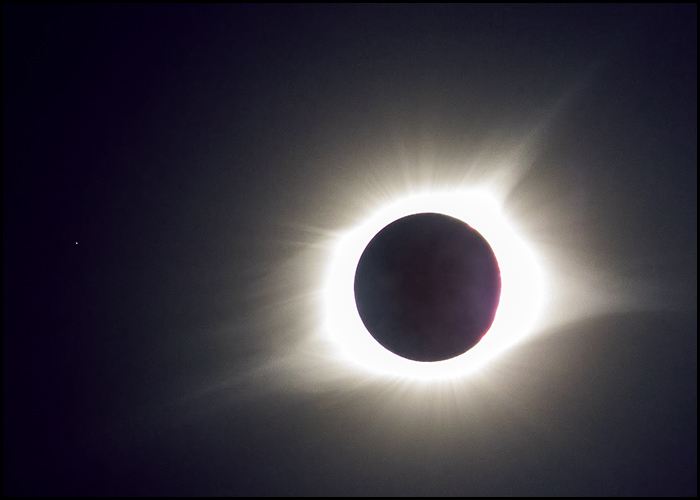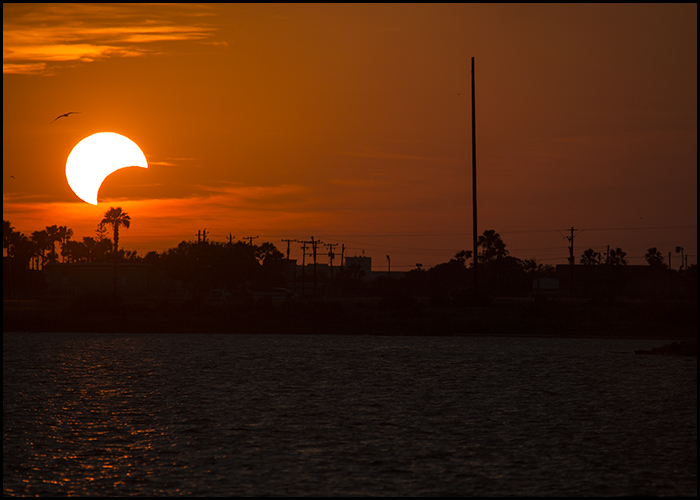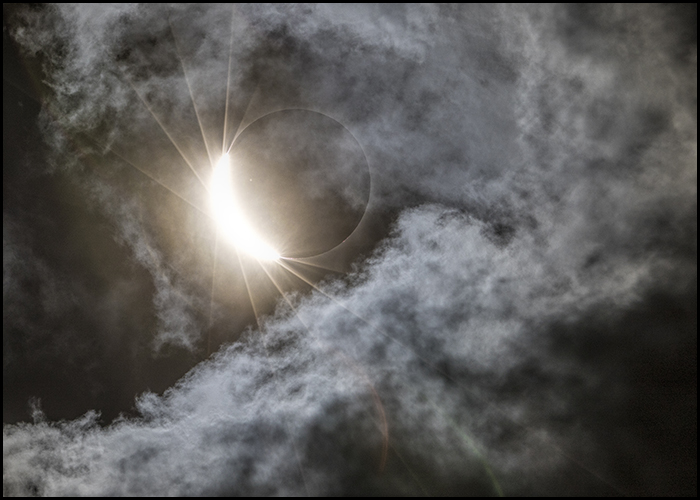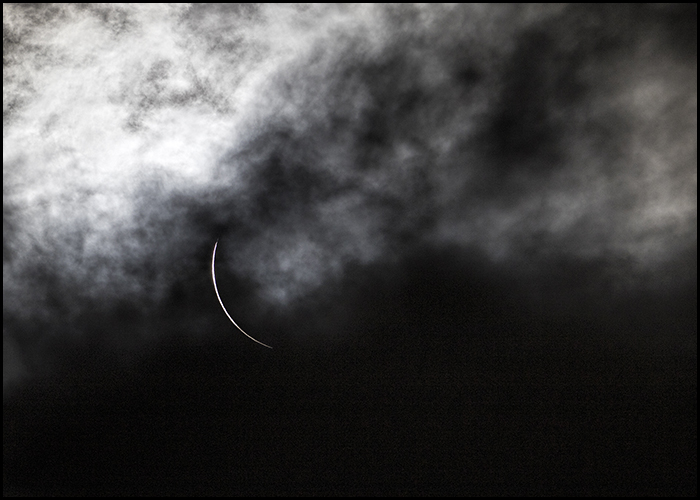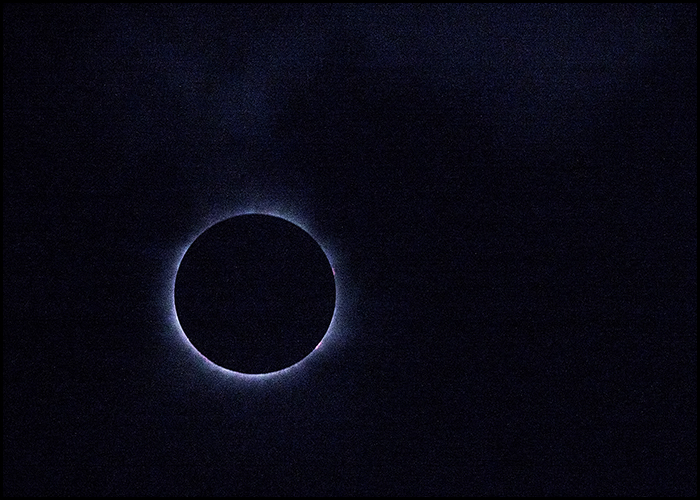[spacer height=”20px”]
[spacer height=”20px”]
For those interested in folklore and mythology, there are volumes of material surrounding the occurrence of solar eclipses. When viewed through the spectacles of modern science, the mythology and folklore appear quaint or even laughable. For example, who would believe that a giant wolf took a bite out of the sun? In Norse culture, an evil enchanter, Loki, was put into chains by the gods. Loki got revenge by creating wolf-like giants, one of which swallowed the Sun and caused a solar eclipse.
In India and Armenia, a dragon swallowed the sun, while Chippewa people shot flaming arrows into the air trying to reignite the sun. In Siberia, China, and Mongolia, it was believed that beheaded mythical characters chased and swallowed the sun. In Columbia, natives shouted to the heavens and promised to mend their ways, apparently believing their bad behavior caused the solar eclipse. In Transylvania, an angry sun turned away and covered herself with darkness because of the bad behavior of men. However, other cultures took a different view of solar eclipses and found them to be romantic.
[spacer height=”20px”]
[spacer height=”20px”]
In a Tahitian myth, the moon and sun are lovers who joined up and caused an eclipse. The West Africans believed when the sun and moon got together, they turned off the light for privacy. In German mythology, the sun and moon were married. Seeking companionship, the moon was drawn to his bride, and they came together creating a solar eclipse. To the Australian Aborigines, the sun was seen as a woman who carries a torch. The moon, was regarded as a man. A solar eclipse was interpreted as the moon uniting with the sun. Certainly, the romantic view comes closer to the truth in describing a solar eclipse. It definitely is the relationship between the sun and the moon, and ancient astronomers and astrologers have been studying and predicting the event for eons.
Ancient observations of solar eclipses can be traced back to at least 2500 BC in China and Babylon. By 2300 BC, ancient Chinese astrologers believed a total solar eclipse was a major element of forecasting the future health and successes of the emperor. Similar records can be found for the early Greeks. Unfortunately, ancient Egyptian records have been destroyed as well as ancient Mayan records, but other evidence such as the Mayan calendar suggests they had an informed knowledge of solar eclipses. Given the frequency of solar eclipses, which occur 75 out of 100 years, it understandable that they have been the subject of interest and study for ages, and the interest continues to this day.
[spacer height=”20px”]
[spacer height=”20px”]
Our most recent solar eclipse occurred on August 21, 2017, and could be seen across the entire United States. It was widely reported in the news, and eclipse viewing glasses were being sold at Lowe’s, Walmart, and other retailers including Amazon. On Wednesday before the big event, I began looking for eclipse viewing glasses. I went to Lowe’s, but they were sold out. However, I found solar viewing glasses in Walmart’s optical department. I bought several pair and returned home. I tested my glasses by looking into the sun; they worked well. Pleased at my purchase, I sat outside on the patio to contemplate the event. I had seen a partial eclipse five years earlier, and I had taken several photos that were good enough but not great. As I anticipated photographing the current eclipse, the lyrics to “You’re So Vain” kept running through my head, particularly the line, “Then you flew your Lear jet up to Nova Scotia to see the total eclipse of the sun.” Carly Simon’s line would not go away, and I began to think about the possibility of seeing the total eclipse, not the partial eclipse I had seen before.
I went to bed thinking I would not have to fly to Nova Scotia to see the total eclipse. I could drive to Kansas or Kentucky and witness it firsthand. “It is not that far,” I thought. “I can drive it easily.” After a restless night, the thought of a total solar eclipse grew larger in my mind and plagued my thoughts at every turn. I did not like the idea of photographing a partial eclipse, but I decided to buy a solar filter for my camera lens, so that I could. To my surprise, no online vendor had the filter I needed. Frustrated, I settled for a neutral density filter that I knew was not dark enough, but it might get me by in a pinch. Also, I thought if I could only see the total eclipse, I would not need a filter. The darkened sun does not require a filter to photograph it, and the darkened sun can be safely viewed with the naked eye. As Carly Simon sang softly in my ear, I imagined what it would be like. Twilight, then darkness, then twilight again, and it would happen in a matter of minutes. It would be fascinating – a thing to remember for a lifetime, and it was all going to happen within driving distance.
It is a fine thing to allow your imagination to run wild, but at some point you have to face practical matters, and from a practical viewpoint driving 1,000 miles, more or less, to watch the sun for two minutes and thirty seconds seemed a bit impractical even to me. Also, there would be a long 1,000 mile, more or less, drive home. For the rest of the day, I toyed with the idea off and on – imagining the exhilaration and dreading the drive. Honestly, I thought my idea was a bit over the top, and I had not mentioned it to anyone. In a way, I feared the response I was sure to get, but it really is a fine thing to allow your imagination to run wild.
I was sitting on the patio with my wife as the sun set, and without hesitation, I suggested we should go see the total eclipse ourselves. After all, it is a chance of a lifetime I argued, and it is not that far. We could drive it easily in a day I said to her. And I went on with whatever I thought might be a selling point. When I finally quit talking, she asked, “How far is it? How long will it take? Where will we stay?” I did not have all the answers, but she had not said no, so I continued with the chance-of-a-lifetime argument. “Kind of like seeing Haley’s comet,” I said, which we had seen several years before and found it to be a disappointment. “Can you imagine it turning dark in the middle of the day? Will roosters really crow? Will it be noticeably cooler?” I questioned? Finally she said we could go, but we needed a plan. After studying the map I suggested Kentucky because it had the longest viewing time and was about the same distance as Kansas. She immediately began to look for rooms for Sunday night, but none was available near Hopkinsville, our intended destination. Finally, she found a room in Dyersburg, Kentucky; we booked it. I was elated, but the planning had just begun.
[spacer height=”20px”]
[spacer height=”20px”]
I intended to leave Sunday morning and drive straight to Kentucky, but that plan needed approval which was not forthcoming. Instead, I compromised and left Saturday afternoon. This was not my idea of a good plan, but we were going, and that is all that mattered. We spent the night in Texarkana and arrived in Dyersburg early Sunday. Dyersburg is a small agricultural community where cotton is still king, and it is about a two hour drive to Hopkinsville. By the time we reached Dyersburg, we had decided that Hopkinsville was not our destination. The enterprising residents of Hopkinsville were renting 64 square feet of their lawns to eclipse viewers, and people from all over the world were descending on Hopkinsville. There were estimates of 75,000 visitors and upwards in a town of around 31,000 inhabitants. It was not that appealing, so we decided to view the eclipse from the Walmart parking lot in Benton, Kentucky. It was a pretty good plan. When we got on the road to Benton Monday morning, there was very little traffic, so we decided to go even closer to Hopkinsville. We would go to Eddyville and view the eclipse from the Walmart parking lot in Eddyville. While in route, my wife noticed a state park on the map just outside of Eddyville, so we decided to investigate the park. When we arrived at the park, we found a large parking lot at the visitor center, but it was filling up fast. We found a vacant spot and parked. This was our destination! It was about 10:00 a.m., and we had arrived.
[spacer height=”20px”]
[spacer height=”20px”]
I unpacked the lawn chairs and the ice chest and set up the umbrella. It was about 98 degrees with clear skies. It was a perfect day for an eclipse, and eager eclipse viewers in the park were trying out their glasses and staring at the sun. Some were holding glasses in front of their cell phones and taking pictures. A quick glance around the parking lot revealed the license plates, and they were from all over the country. The atmosphere was festive and friendly with people sharing stories of their travels. One person I met from Annapolis, Maryland, had first gone to St. Louis to view the eclipse but decided there were too many clouds in St. Louis and had just driven to Kentucky this morning. Others had planned their travel months in advance and purposely selected the state park we were in. I did not bother to tell them that we had stopped on our way to Walmart. We were in Land Between the Lakes Park on the Kentucky side. The park is shared by Kentucky and Tennessee and can be entered from either state.
[spacer height=”20px”]
[spacer height=”20px”]
The eclipse had started, but the total eclipse would not occur until 1:30 pm. Periodically I put on my glasses to monitor the progress. I am happy to report that a giant wolf was indeed biting off huge chunks of the sun. It was disappearing in steady increments, and I took a few photos of the progress. It was blinding looking through a telephoto camera lens at the sun – even with my darkest neutral density filter. I would only glimpse at the sun and release the shutter blindly. The twilight had begun, and it produced an eerie, greenish light. I tried to photograph the twilight, but the photos are a poor representation of reality, as is often the case with photography. The camera lacks the nuanced sophistication of the human eye.
[spacer height=”20px”]
[spacer height=”20px”]
The park was now almost silent as onlookers anticipated the coming event. As a small cloud approached the sun and threatened to block our view, the silence was broken by sighs of disappointment. The silence returned as the cloud passed from view. Only moments before the total eclipse, yet another cloud passed in front of the sun and the sighs were louder, but it too quickly passed away, and applause replaced the sighs. It was now dark, and stars twinkled in the sky. The total eclipse had arrived, and the corona was readily visible at the edge of the darkened sun. Cameras were snapping away rapidly, and dogs began to bark and howl. The cameras were being triggered by humans, but only Heaven knows what triggered the dogs. In two minutes and thirty seconds the sun was returning, and twilight was reversing. The temperature now hovered at 83 degrees, and it was over. In my life’s history, I have no other frame of reference for comparison. It is perhaps as Wendy Mass has said, “Comparing what you see during an eclipse to the darkness at night is like comparing an ocean to a teardrop.” To me, it was simply euphoric.
Until next time…
